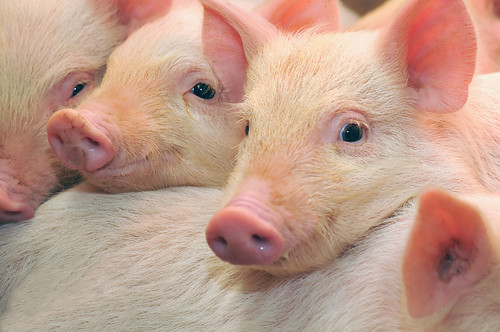
SweetAnimals
The SweetAnimal project studies the presence of sugar-binding receptors in the genomes of a variety of farmed animals, how these differ between species, what ligands expressed on pathogens they bind, and how this information can be used to develop carbohydrate-based vaccines.

Challenge
It is becoming increasingly clear that our approaches to vaccination so far may not be sufficient in situations where we must protect newborns before they become fully exposed to a pathogen, especially when the pathogens infect via the mucosal surfaces. To invade host cells, pathogen often use an initially loose binding to the cells, involving the interaction of sugars expressed on their surface with the corresponding receptors on the host cell surface. Interestingly, the sugars expressed on pathogens are different to those expressed by the mammalian host, allowing potentially for new vaccine approaches to be engineered.
The SweetAnimals project, led by Professor Dirk Werling, hast started to address these questions in several interlinked study and has made discoveries that may contribute to the development of new vaccine approaches for economically endemic and exotic diseases in farmed animals.
Objectives of the SweetAnimals projects are
- Identify sugar receptors present or absent within the genomes of various farmed animal species in comparative studies to human and mice
- Assess the ligand-binding spectrum of these identified receptors compared to their human/murine orthologues
- Identify appropriate ligands on pathogens
- Use this information to aid the development of carbohydrate-based vaccines

Solution
Genomic comparison
We have identified a variety of species-specific receptors, which are not present in the human or murine genome. This has not only led to explanation why some cell markers have not been detected in these species over the last decades, but may also point to the fact that there is a really strong evolution between pathogens and their hosts, this indicating that specifically the murine system may be not useful for vaccine design in farmed animals.
C-type lectin arrays
Together with collaborators at Imperial College, we tested a platform technology to assess binding of specific pathogens to a variety of sugar receptors.
Identification of pathogen specific sugars
Using the above gained information, as well as information gained in further studies, we are currently investigating the presence of pathogen-specific sugar moieties that may interact with host receptors.
Vaccine development
We have developed a vaccine platform for oral delivery that has been successfully tested across several species and pathogens. We hope to increase the efficacy of this system through the currently running studies.

Impact
Our work performed so far, and the current on-going studies will be the first to assess specific components of the innate immune system in a variety of farmed animals. This has led to the not necessarily surprising finding that cow and pigs are most closely related, and both species are closer related to humans than to mice. The subsequent work has shown that pathogens use a distinct set of receptors to potentially attach to host cells, and these receptors vary between pathogens from the same family. The work has also allowed us to develop in-vitro testing systems to assess host-pathogen interaction in far more detail, thus significantly reducing the number of experimental animals necessary. Finally, the work has resulted in the development of a vaccine platform specifically targeting sugar receptors expressed on mucosal surfaces. The activation of these receptors increased not only the innate immune response, but also resulted in an adaptive immune response, leading to a substantial protection of challenged animals. The findings of our research have been published in several papers. In addition, the team have presented at various UK and international meetings.
Partners
We thank our partners, Profs Kurt Drickamer and Maureen Taylor, both Imperial College London, Dr Mark Pfuhl (UCL) and Petra Lukacik (Diamond Light Source) for their help and collaboration. We thank the BBSRC, Bill and Melinda Gates Foundation, GalvMed, Bloomsbury SET, Zoetis Animal Health and Boehringer Ingelheim for funding varies aspects of the research (Advanced Grant 323041).
Publications
|
Title |
Publication |
Year |
|
A Novel Whole Yeast-Based Subunit Oral Vaccine Against Eimeria tenella in Chickens |
Frontiers in Immunology |
2022 |
|
Pathogens |
2021 |
|
|
Frontiers in Veterinary Science |
2021 |
|
|
PLoS Pathogens |
2021 |
|
|
Frontiers in Immunology |
2021 |
|
|
Use of Precision-Cut Tissue Slices as a Translational Model to Study Host-Pathogen Interaction. |
Frontiers in Veterinary Science |
2021 |
|
Development of a Potential Yeast-Based Vaccine Platform for Theileria parva Infection in Cattle. |
Frontiers in Immunology |
2021 |
|
International Journal of Molecular Science |
2021 |
|
|
Transboundary and Emerging Diseases |
2021 |
|
|
Frontiers in Immunology |
2021 |
|
|
Poultry Coccidiosis: Design and Interpretation of Vaccine Studies. |
Frontiers in Veterinary Sciences |
2020 |
|
Mammalian lectin arrays for screening host-microbe interactions. |
Journal of Biochemistry |
2020 |
|
Molecular Immunology |
2020 |
|
|
Frontiers in Microbiology |
2020 |
|
|
Frontiers in Immunology |
2019 |
|
|
CD23 is a glycan-binding receptor in some mammalian species. |
Journal of Biochemistry |
2019 |
|
Innate Immunity |
||
|
Innate Immunity |
2017 |
|
|
Identification of Theileria lestoquardi Antigens Recognized by CD8+ T Cells. |
PLoS ONE |
2016 |
|
Veterinary Microbiology |
2016 |
|
|
Vaccine |
2015 |
